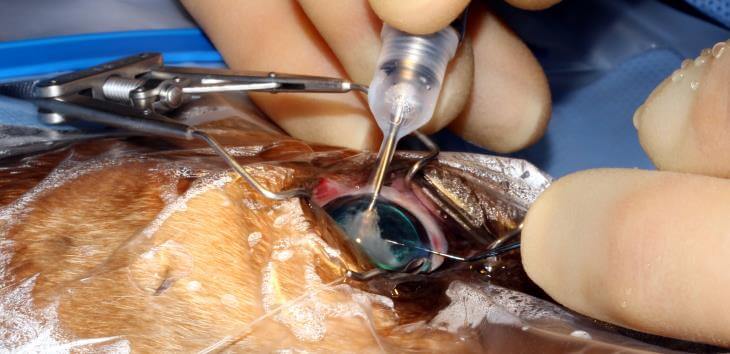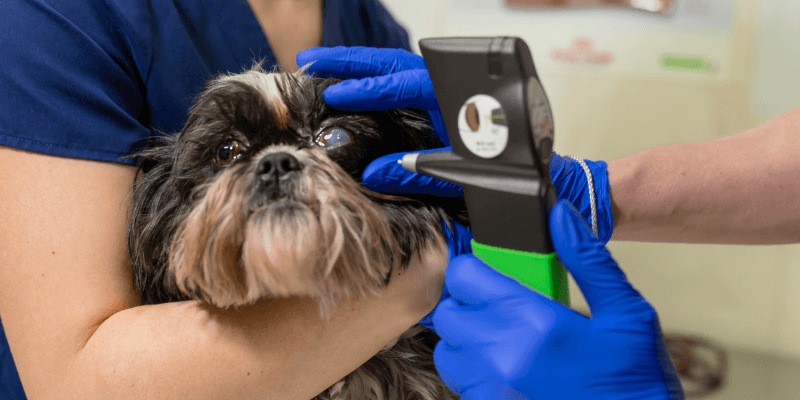The anatomy of dogs’ eyes is very similar to that of human beings.
Both sets of eyes have a cornea (a clear tissue that forms the topmost layer of the eye), an iris, and a pupil.
The only difference is that human beings have two eyelids, while dogs have three, one of which is known as the nictitating membrane (a granular layer located underneath the bottom eyelid).
Usually, the cornea receives light and focuses light rays on the retina, allowing your dog to see clearly.
What Are Cataracts?

Unfortunately, another similarity between human and dog eyes is that cataracts can also develop in the latter, thereby negatively affecting your dog’s eyesight.
Cataracts are defined as opacifications of the cornea such that this lens is unable to effectively focus light on the retina, hampering your pet’s vision.
In most cases, cataracts come in the form of a cloud-like obstruction that covers part or the entire cornea.
It can result in blurred vision and eventually lead to blindness once the cataract fully disintegrates in its hyper-maturity phase.
In the early stages, commonly referred to as incipient cataracts, the corneal opacification is hardly visible and the dog’s eyesight is not affected.
However, this condition deteriorates with time as the cornea becomes so cloudy that the retina cannot be identified, leading to complete blindness.
Cataracts can be easily confused with nuclear sclerosis, a mild cloudiness in the eye that barely affects a dog’s vision.
It is important to seek medical assistance once you notice any odd symptoms in your dog’s eyes to get a valid diagnosis and to start medication immediately, failure to which cataracts might deteriorate further into the hyper-maturity phase.
What is Cataract Surgery?
Cataract surgery is conducted by a veterinary ophthalmologist and is aimed at restoring your dog’s eyesight by getting rid of the cloudy lens.
It involves a process known as phacoemulsification whereby the ophthalmologist makes tiny incisions on the cornea and uses a machine that emits ultrasound vibrations to split up the cloudy lens.
Afterward, a suction pump is used to remove the broken fragments, leaving the unaffected parts of the lens capsule.
An IOL (intraocular lens) is inserted in the place of the broken lens to restore the dog’s vision.
Finally, sutures are used to close the wound.
Some ophthalmologists prefer to suture the eye completely for a few hours as the anesthesia wears out to protect the wound.
Once the dog is awake, a cone, known as an Elizabeth collar, is placed around the dog’s neck for the next few weeks to prevent the dog from tampering with the eye before it is fully healed.
You should, however, note that not all dogs qualify for cataract surgery.
Your dog has to undergo pre-surgery testing to ensure its retina functions accordingly, there is little to no inflammation, and there is no glaucoma as evidenced by the normal pressure range inside the eye.
These tests include an eye ultrasound and an electroretinogram (ERG).
Dogs found with retinal disintegration or hyper-mature cataracts cannot undergo this surgery.
Additionally, dogs with health issues that make them hypersensitive to anesthesia can also not undergo this procedure.
For instance, ophthalmologists take extra precautions when administering anesthesia to sighthound breeds, such as Whippets and Salukis, given that their genetic makeup and metabolism hampers their ability to effectively metabolize anesthetic shots.

Pros
Cataract surgery is beneficial as it restores your dog’s eyesight.
According to MVS , 95% of canines that undergo this procedure have their eyesight restored after the operation.
What’s more, 90% of these dogs retain their vision 12 months after the operation while around 80% retain a positive prognosis 24 months after the operation.
As such, the primary benefit of this procedure is that it will greatly improve your dog’s quality of life by restoring its vision.
Another notable benefit is that cataract surgery involves removing all the diseased tissue from your dog’s eyes.
Consequently, the inflammation inside the eyes that was causing discomfort and pain will subside. This also contributes to improved eyesight.
Cataract surgery will also help protect your dog’s eyesight and general health from possible secondary problems.
If left untreated, the cataract-induced inflammation in the eyes is capable of bringing about issues such as glaucoma and retinal detachment.
So, this surgical treatment minimizes the risk of these secondary issues, thereby safeguarding your pet’s future health.
Lastly, you will be relieved to find out that cataract surgery will take only a few hours.
Unlike other complex surgeries that can take up days, you and your dog can leave the ophthalmologist’s office in a few hours with the issue fully resolved.
This makes cataract surgery a convenient treatment option.
Cons
On the flip side, like any other operation, cataract surgeries have a slight risk of surgical complications.
It is estimated that around 5% of dogs that undergo this procedure experience complications such as surgical site infections, uveitis (inflammation of the eyes), hyphema (eye bleeding), and corneal ulcerations.
In the more severe cases, operated dogs can experience glaucoma due to a gradual increase in intraocular pressure.
Other possible risks include displacement of the lens implant, retinal degeneration, and scarring of the cornea.
Cataract surgeries are also costly in terms of price and time.
Your dog will wake up in around three hours, but the anesthesia-induced grogginess will fully fade off in 2 days.
The dog will need an additional 6 weeks to fully recover and multiple monthly check-ups for up to one year and a half to establish the full long-term prognosis.
Apart from the time consumed, you will also have to incur a significant sum of money to facilitate this procedure.
Pre-operative tests can cost up to $1,000 while the actual surgery can go for up to $4,800.
These rates are not inclusive of follow-up visits.
It is also important to note that cataract surgery is a highly invasive treatment protocol that exposes your beloved pet to a host of health risks.
Due to the surgical nature of this process, your dog is likely to experience physical as well as mental distress, as the procedure involves administering anesthesia and cutting open parts of the dog’s eyes.
In particular, dogs that have some sort of reaction to the anesthetic agent may suffer minor issues, such as frequent vomiting and mild swelling at the injection site, or more serious problems, such as stroke or cardiac arrest.
However, the anesthetic risk is higher for specific breeds. This level of risk is largely determined by the dog’s age, size, health, and breed.
How Long Does Cataract Surgery Last In Dogs?
This procedure takes a few hours from check-in to discharge.
The initial recovery period will be about 2 weeks, during which the dog is required to wear an Elizabeth collar at all times.
Afterward, full recovery and follow-up appointments can last for 12 to 18 months.

Is Cataract Surgery Worth it For Older Dogs?
As the old adage goes, age is just but a number.
The same applies to dogs and cataract surgery.
Thanks to the recent breed of high-tech surgery equipment, canines as old as ten years have successfully undergone this delicate procedure.
However, there are specific concerns that are more commonly found in older dogs that are likely to inhibit the need for cataract surgery.
Top of the list is that your dog might also be suffering from age-related eye degeneration that cannot be rectified with this procedure.
There is also the risk of diminished brain functions on account of old age which further contributes to bad eyes.
If pre-operative tests show any of these complications, your old dog might not benefit much from cataract surgery.
Your veterinarian is likely to prescribe senility drugs and other medication alternatives instead.
Alternatives to Cataract Surgery for Dogs
The most notable alternative to cataract surgery is the use of anti-glycation medicine.
Cataracts are brought about by the atrophy of lens fiber proteins.
Anti-glycation drugs can help control this degeneration by aggregating eye proteins, most notably gamma, beta, and alpha crystalline.
Compared to cataract surgery, this medication is advantageous as it is non-invasive, relies mainly on naturally occurring compounds, has zero risk of postoperative complications, and does not involve anesthesia.
However, it cannot resolve diabetic cataracts, leaving surgery as the only remedy for this condition.
Lanosterol-based eye drops have also been recently identified as a valid alternative to cataract surgery.
A study conducted by the University of California established that lanosterol is capable of reversing protein aggregation in eye lenses, making it a viable treatment for cataracts in dogs. Learn more here: Lanosterol Eye Drops for Dogs Review
However, its safety is yet to be fully ascertained since this is a fairly new drug.
You may also want to check: 10 Best Eye Drops for Dogs with Cataracts
Resources
https://pubmed.ncbi.nlm.nih.gov/26200341/
https://www.frontierpet.com/site/blog/2021/11/15/cataract-surgery-dog
https://www.animaleyecare.com.au/vet-info/cataracts/166-cataracts-surgery.html
As an Amazon Associate, we may receive a small commission from qualifying purchases but at no extra cost to you. Learn more. Amazon and the Amazon logo are trademarks of Amazon.com, Inc, or its affiliates.

